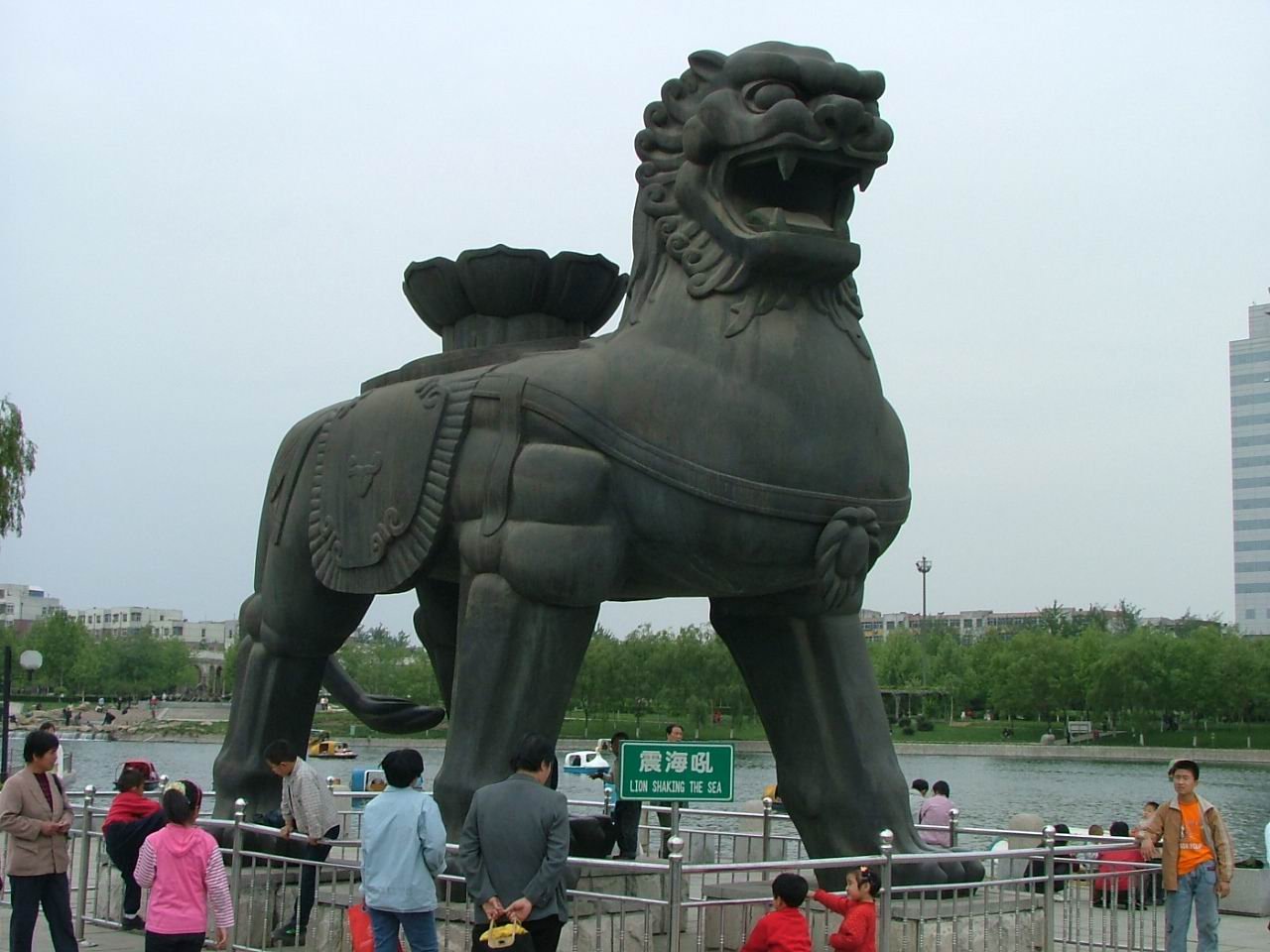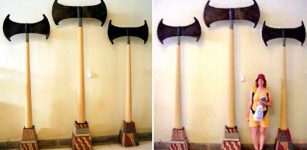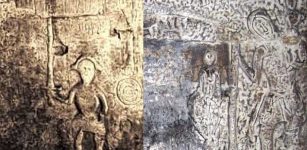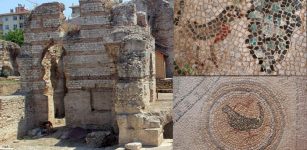Incredible Ancient Metallurgical Wonders That Defy Explanation And Pose A Real Mystery Even Today
A. Sutherland - AncientPages.com - The Antediluvians had technologies that matched our own; there are also serious indications that in certain areas they even possessed extraordinary knowledge, which has only hardly been nudged by our present-day science.
The 13m high Yu Quan pagoda at Dangyang (Hubei) is created entirely of cast iron. Erected in 1061, it is the oldest surviving cast-iron pagoda. Image courtesy: General Office of Hubei Provincial People's Government
Highly advanced hardening techniques of the ancients as well as ancient castings of large pieces were widespread in antiquity.
Our ancestors were in possession of an extremely sophisticated scientific knowledge of metalworking from an earlier civilization and evidence of this knowledge was found in different parts of the world.
China with a long history in metallurgy was the earliest civilization that manufactured cast iron and some of the ancient Chinese feats of casting iron are so impressive as to be almost unbelievable.
One of them is for example, the cast-iron pagoda entirely built of cast iron at Dangyang, Hubei Province, China, in 1061. It is the tallest (17.9 m high) surviving cast-iron structure, which has 13 stories, built up of cast-iron octagonal sections fitted together by a tenon-and-mortise system.
One large sculpture of legendary fame is the majestic cast-iron lion situated not far from the Grand Canal at Cangzhou, Hebei Province. It was manufactured in 953 AD.
The gigantic lion (5.4×3×5.3 m) weighs over 37 tons. It is hollow and the thickness of its walls varies from 40 to 20 cm. On its back is a lotus pedestal of cast iron weighing circa 5 tons.
 Majestic gigantic cast-iron lion at Cangzhou, Hebei Province was manufactured in 953 AD. It weighs over 37 tons. source
Majestic gigantic cast-iron lion at Cangzhou, Hebei Province was manufactured in 953 AD. It weighs over 37 tons. source
"The mystery of the use of iron in India and China is one that largely baffles modern metallurgists. It is assumed that these countries developed iron and other metallurgical skills after the west, but the evidence points otherwise," says D. H. Childress in his book "Technology of the Gods: The Incredible Sciences of the Ancients" and cites South African archaeologist Nikolaus van der Merwe, saying that "spreading east from the Mediterranean, iron was diffused throughout most of Asia before the Christian era.
"By 1100 BC it was in use in Persia, from where it spread to Pakistan and India. The date of the arrival of iron in India is still a matter of some dispute..."
Ancient Indians, for example, produced iron capable of withstanding corrosion, most likely due to the high phosphorus content of the iron produced during those times.
The height of the pillar, from the top to the bottom of its base, is 7.21 m (23 ft 8 in), 1.12 m (3 ft 8 in) of which is below ground. Its bell pattern capital is 306 mm (12 in). It probably weighs more than three tonnes (6,614 lb). The pillar that stands in the courtyard of Kutb Minar in Delhi, India, has attracted the large attention of archaeologists and specialists because of its high resistance to corrosion and has been called a "testimony to the high level of skill achieved by the ancient Indian iron smiths in the extraction and processing of iron"
Detail showing the inscription of King Chandragupta II, who was one of the most powerful emperors of the Gupta Empire in India. Image credit: User:~shuri - Public Domain
An inscription in the Sanscrit language informs that the column was originally erected in the temple of Muttra and capped with Garuda - "Messenger of the Gods" - an image of the bird incarnation of the god Vishnu, the Indian god known as "The Preserver".
But Muslim invaders destroyed the Garuda and tore the column from its original setting and moved it to the current place in Delhi in the eleventh century. It is unknown how long this impressive iron shaft had been at Muttra.
What was it meant to represent? Was it merely a religious symbol or did it serve any other purpose? To which era does the pillar really belong?
Many legends are devoted to the Ashoka Pillar also known as the Iron Pillar in Delhi, which is said to be in existence for the past 1600 years, but some scholars believe the structure is a few millennia old.
This metallurgical wonder defies explanation and poses a real mystery even today, due to its enormous size and a sizeable casting job related to it. It is difficult to even imagine how such a huge mass of iron was lifted and manipulated during manufacture.
How did the structure manage to "survive" under the Indian tropical heat and violent monsoon downpours?
The iron pillar stands within the courtyard of Quwwat-ul-Islam Mosque. Image credit: stevekc - CC BY 2.0
The column - made up of 98% wrought iron of impure quality - not in any way welded together - seems to have been forged as a single, gigantic piece of iron.
Normally a piece of iron manufactured 1600 years ago would have corroded long ago. But it is not the only mystery of the Ashoka Pillar.
The column - made up of 98% wrought iron of impure quality - not in any way welded together - seems to have been forged as a single, gigantic piece of iron.
Iron with exceptionally high purity can be produced today under controlled laboratory conditions by electrolysis. This knowledge was not duplicated until recent times. It was even possible to produce iron of comparable purity in 1938.
The iron column exists at Kottenforst has its local name the "Iron Man". Image credit: Chris Walters - Public Domain
It was placed at its present location around 1727, but where was it earlier? The artifact has been shrouded in mystery for centuries and still remains the subject of scholarly speculation. Who made it, how and why, is unknown.
Fabrication of the Iron Pillar, seven-ton heavy and seven-meter tall known for its amazing corrosion resistance despite exposure to the wind, sun, and rain in the open for more than 16 centuries is undoubtedly a metallurgical marvel of the ancients.
How metallurgists of ancient India achieved this level of iron purity and what kind of technique they used to cast such enormous iron pillars - remains a mystery.
Another mysterious iron column exists at Kottenforst, a few miles west of Bonn, Germany. It has its local name the "Iron Man". It has the appearance of a squared metal bar, with 4 feet 10 inches above the ground and an estimated 9 feet beneath the surface. The pillar is a unique oddity in Central Europe, and is alleged by some to be an out-of-place artifact.
Like the iron pillar of India, the "Iron Man" of Kottenforst shows some weathering but very little trace of rust.
Who made it, how and why, is unknown.
Written by – A. Sutherland AncientPages.com Staff Writer
Copyright © AncientPages.com All rights reserved. This material may not be published, broadcast, rewritten or redistributed in whole or part without the express written permission of AncientPages.com
More From Ancient Pages
-
 On This Day In History: Johannes Kepler ‘Father Of Modern Astronomy’ Was Born – On Dec 27, 1571
News | Dec 27, 2016
On This Day In History: Johannes Kepler ‘Father Of Modern Astronomy’ Was Born – On Dec 27, 1571
News | Dec 27, 2016 -
 Mysterious Death Of Cambyses II – Natural, Suicide Or Assassination By Darius I The Great?
Featured Stories | Apr 21, 2021
Mysterious Death Of Cambyses II – Natural, Suicide Or Assassination By Darius I The Great?
Featured Stories | Apr 21, 2021 -
 Mysterious Ancient Vanished Civilization With Unusual Physical Characteristics – Survivors Of The World’s First Race? – Part 1
Ancient Mysteries | Aug 17, 2020
Mysterious Ancient Vanished Civilization With Unusual Physical Characteristics – Survivors Of The World’s First Race? – Part 1
Ancient Mysteries | Aug 17, 2020 -
 Captain James Cook’s Famed Vessel The Endeavour Possibly Discovered On The Coast Of Rhode Island
Archaeology | Feb 4, 2022
Captain James Cook’s Famed Vessel The Endeavour Possibly Discovered On The Coast Of Rhode Island
Archaeology | Feb 4, 2022 -
 Dangerous Magnetic Anomaly And Unexplained Events In Mysterious And Dark Valley Trouble Scientists – Why Must The Stone Gate Not Be Crossed?
Featured Stories | Nov 7, 2024
Dangerous Magnetic Anomaly And Unexplained Events In Mysterious And Dark Valley Trouble Scientists – Why Must The Stone Gate Not Be Crossed?
Featured Stories | Nov 7, 2024 -
 Giant Ancient Minoan Axes Used For Unknown Purposes
Artifacts | Nov 27, 2017
Giant Ancient Minoan Axes Used For Unknown Purposes
Artifacts | Nov 27, 2017 -
 Why Did King Solomon Hide Advanced Technology In A Secret Place? First Visit – Part 1
Ancient Mysteries | Mar 30, 2021
Why Did King Solomon Hide Advanced Technology In A Secret Place? First Visit – Part 1
Ancient Mysteries | Mar 30, 2021 -
 Mysterious Royston Cave And Its Unexplained Carvings Still Puzzle Scientists
Featured Stories | Jan 11, 2014
Mysterious Royston Cave And Its Unexplained Carvings Still Puzzle Scientists
Featured Stories | Jan 11, 2014 -
 Jigai – Suicide Ritual For Wives Of Samurai – Feminine Counterpart Of Seppuku
Ancient History Facts | Feb 24, 2018
Jigai – Suicide Ritual For Wives Of Samurai – Feminine Counterpart Of Seppuku
Ancient History Facts | Feb 24, 2018 -
 Enigmatic Footprints Reveal Humans Were In Spain 200,000 Years Earlier Than Previously Thought
Archaeology | Nov 11, 2022
Enigmatic Footprints Reveal Humans Were In Spain 200,000 Years Earlier Than Previously Thought
Archaeology | Nov 11, 2022 -
 Scientists Closer To Solving The Mystery Of When Animals Evolved
Evolution | Jul 6, 2023
Scientists Closer To Solving The Mystery Of When Animals Evolved
Evolution | Jul 6, 2023 -
 Controversial 5,500-Year-Old Sumerian Star Map Of Ancient Nineveh Reveals Observation Of Köfels’ Impact Event
Artifacts | Dec 28, 2018
Controversial 5,500-Year-Old Sumerian Star Map Of Ancient Nineveh Reveals Observation Of Köfels’ Impact Event
Artifacts | Dec 28, 2018 -
 Migration Of Early Humans Out Of Africa Began Thousands Of Years Earlier Than Previously Thought
Archaeology | Dec 18, 2017
Migration Of Early Humans Out Of Africa Began Thousands Of Years Earlier Than Previously Thought
Archaeology | Dec 18, 2017 -
 Ancient Thriving Market Of Khan al-Tujjar (The Merchants’ Caravanserai) Discovered In Lower Galilee
Archaeology | Feb 20, 2024
Ancient Thriving Market Of Khan al-Tujjar (The Merchants’ Caravanserai) Discovered In Lower Galilee
Archaeology | Feb 20, 2024 -
 Ancient Mystery Of America’s Missing Metal – Can The Answer Be Found In Ancient Europe?
Ancient Mysteries | May 18, 2018
Ancient Mystery Of America’s Missing Metal – Can The Answer Be Found In Ancient Europe?
Ancient Mysteries | May 18, 2018 -
 Unexplained Ancient Wars In America – Strange Physical Evidence – Part 2
Ancient Mysteries | Oct 4, 2020
Unexplained Ancient Wars In America – Strange Physical Evidence – Part 2
Ancient Mysteries | Oct 4, 2020 -
 Beautiful Zeugma-Like Mosaics Unearthed In Sinop Province, Northern Turkey
Archaeology | Oct 17, 2020
Beautiful Zeugma-Like Mosaics Unearthed In Sinop Province, Northern Turkey
Archaeology | Oct 17, 2020 -
 Is Legendary Norumbega In North America A Lost Viking Settlement?
Featured Stories | Jan 8, 2021
Is Legendary Norumbega In North America A Lost Viking Settlement?
Featured Stories | Jan 8, 2021 -
 Unknown Ancient Structures Discovered At Machu Picchu By LIDAR
Archaeology | Mar 29, 2022
Unknown Ancient Structures Discovered At Machu Picchu By LIDAR
Archaeology | Mar 29, 2022 -
 Mysterious Ancient Ruins Of Engaruka – Why Was The Site Abandoned?
Featured Stories | Apr 18, 2017
Mysterious Ancient Ruins Of Engaruka – Why Was The Site Abandoned?
Featured Stories | Apr 18, 2017




